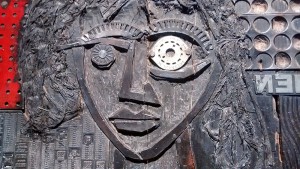Arts Spending in Wisconsin
- Wisconsin ranks 48th out of 50 states for public funding for the arts. In 2018, Wisconsin’s state budget for the arts is $811,800 (14 cents per capita), which has been stagnant since 2015. The entire biennial state budget for Wisconsin in 2015-2017 was $73 billion. That means that the arts are 1/1,000th of 1% of the entire state budget. So if you’re a household that earns $50,000, that’s like setting an annual budget of 50 cents on something your family uses.
- For comparison, a brand new private jet costs minimum $3 million and has an annual maintenance cost of $1 million. In other words, the cost of maintaining the cheapest private jet that one person can enjoy is more than the cost of 5.7 million people’s arts and culture experience.
Arts Spending vs the State Budget
- Scott Walker just signed a biennial budget for 2017-2019 for $76 billion. In Fiscal Year 2019, arts funding will drop to $763,000. This means that while the state budget increased by 4%, the state arts budget decreased by 6.4%. The only time that funding for Wisconsin has been lower was in 2012, when Scott Walker cut the arts budget in Wisconsin from $2.4 million to $759,000. To understand how drastic that is, consider that there are 473,000 children in low-income families in Wisconsin, and every single one of them lost their access to basic art supplies for the whole school year.
- If Wisconsin’s arts spending had kept up with inflation in the last 7 years (after the 2012 budget cut), then Wisconsin’s 2019 arts budget should be minimum $906,000. So we have lost about $100,000 of our purchasing power in the last 7 years and are about to lose another $52,000 in state funding.
- The 2012 budget cuts came right after the recession, so some people will argue that the arts must always be the first thing to go when economic times are tough. But if you cut all arts funding in Wisconsin for 30,000 years, it still wouldn’t pay off Wisconsin’s state and local debt of $24 billion.
The 48th Worst Funded State vs Everyone Else
- For comparison, Minnesota is the top ranking state in the US for spending on the arts. In 2019, Minnesota plans to increase spending from $6.36 to $7.04 per capita on the arts for a total state budget of $39 million. This is 54 times greater than Wisconsin’s arts spending.
- While Minnesota looks like the haven of arts and culture spending in the US, compared to other developed nations, the US is still culturally deprived. Germany spends $145 per capita on the arts, or 1,000 times more than Wisconsin spends on the arts.
Art and Taxes
- 48.1% of Wisconsin’s tax revenues come from income taxes. That means the average Wisconsin resident only pays 6 to 7 cents of their annual taxes to the arts. Even in Minnesota, spending on the arts only comes to $3.42 of the income taxes that Minnesotans pay.
- In sum, slashing arts budgets does little to save the middle-class American on their tax bill.
- Also, FYI, if you don’t think taxpayer money should pay for art, remember that when artists donate a work of art to a fundraising auction, they can’t write that donation off on their tax filings. However, if a collector buys that work of art and donates that same piece to the same causes, the collector can write off the purchase as a tax deduction.
Economic Impact of the Arts
- Arts nonprofits in Wisconsin “generated $657 million in economic activity annually, resulting in $75 million in local and state tax revenues…and $555 million in resident income.” $75 million in local and state taxes?? That’s a hell of a return on investment for $811,800. If any other industry had that kind of return, our state would be funding the shit out of it.
- Of that $657 million, $280 million are for event-related expenses, meaning that if people go out to see a show at the theatre, they are also spending at restaurants, on hotels, on babysitters, etc. The reach of the arts goes far beyond arts expenditures.
- The arts outperform both transportation and agriculture in their contribution to economic activity.
- Moreover, the above report focuses solely on arts nonprofits and doesn’t even begin to quantify how much for-profit arts businesses contribute to the state economy.
What Can We Do?
For too long, we’ve accepted low funding and expectations as just the way things are. The only way things change is for people on all fronts to be educated on the problem and to say that enough is enough.
For artists, this means asserting your value and not letting yourself get taken advantage of. Remember that where you set the bar for yourself is where you set the bar for others who are also trying to make a living.
For non-artists, this means re-evaluating how you and your community spend money. Will you buy cheap, disposable goods that don’t last, or well-made artist and artisanal goods that will last a lifetime? Will you invest in monotonous franchises and fast retail, or the unique design of your city, community landmarks, and cultural experiences?
Since we can’t change arts funding in Wisconsin or the US overnight, we need individuals and private/for-profit businesses to step up and invest in the arts. Keep in mind, this doesn’t just mean donating to your local arts charity. It also means hiring artists by businesses across industries. It means building art and design into the forefront of businesses, homes, schools, and public spaces, instead of treating them like an afterthought. Creativity and the Creative Economy are 21st-century buzzwords, and it’s time we put our money where our mouth is.
This essay is a part of a series called Rethinking the Arts, about the challenges we face and what to do about them. Got questions or interested in a particular topic? Comments welcome.
Cover image of watercolor by Jenie Gao.





To me, Wisconsin is “State of the Art” and we need to support all forms of art as well as the Artists. My Artist name is J-Sun, not to say that the world revolves around me, but the world does revolve around art. I think hope makes the world go round. We need hope for the arts more than ever in Ole Wis